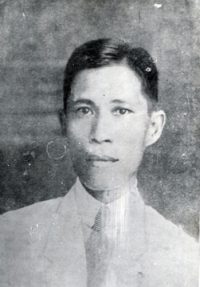After commencing the ascent of Mount Polis we never stopped for rest, and we reached the summit of that lofty mountain at 8 o’clock in the morning. As we commenced to descend we discovered a spring of crystalline water, and here we halted and ate some cooked rice with salt. After eating we at once resumed our journey. It was 2 o’clock in the afternoon. We ascended and descended among these mountains which, it seems are without end. But we had a little satisfaction on the march over the fact that night would overtake us. At 5 p.m. we could see the Banane settlement in the distance, and we arrived there at 8 o’clock at night.
We stopped in this settlement until the 21st of the month. We have seen the “Kanao,” or head-dance.
DESCRIPTION OF KANAO.
The “Kanao” is a feast which the Igorrotes celebrate in each ranch or settlement, when one or any number of them secure the head of an enemy by means of battle or by treachery.
The extensive mountains of northern Luzon are inhabited by a great number of savages, amounting to over 60,000, according to geography. These live in barrios or ranches considerable separated from one another. They exist on “camotes,” or native potatoes, and anything. At times and on extraordinary occasions they have rice to eat. They are a people who go naked, and all of them, men and women alike, wear in their ears huge ornaments, which may be either made of copper wires and teeth, etc. Their bodies are adorned with black points, or painted with divers figures. On their necks they always wear collars of copper wire or cords with pieces of broken plates and other such stuff attached. They only cut their hair in front, letting it grow to a length of about 1½ feet. For greasing their hair they use the fresh fat of the hog.
They live in settlements, each one of which may contain as high as 1,000 Igorrotes. Two settlements can never be on good terms; and there is always enmity between all of them. The inhabitants of one settlement can not visit those of another; they would be killed at once.
Each Igorrote always goes armed with a spear. The Igorrotes have a deep hatred for Christians, but can not fight them face to face: hence are very treacherous.
The “Kanao” is celebrated when they have taken the head of an enemy, the ceremony being as follows:
They cut the head from the dead body and likewise the hands and feet. The head is carried to the house of the chief of the settlement and then is attached to a pole some 12 feet in length and placed inside the house. All the Igorrotes of the ranch, wearing on their heads the white feathers of a rooster, assemble at the house in which the head has been placed. Each Igorrote carries in his hand a spear and a short stick resembling a bandmaster’s wand. Before going to the base for the feast they assemble in groups of 40 or 50; and as they […] up the march they form a line in single file, and all dance as they go along, striking and beating the wands against the lances.
The dance consists in this: Keeping time to the march, they carry one leg to the front, executing movements, contraction and extension, the other leg meantime supporting the weight of the body in the act of leaping. The body forms an outward curve. The arms support the lance and the wand, with which they execute movements to the sound of the dance. Several Igorrotes executing this dance and wearing plumage on their heads present a confusing scene to the vision at first glance.
Once arrived at the house of the festivities the Igorrotes all dance around the amputated head. They use the hands and feet of the corpse for scrubbing their faces.
This ceremony lasts for six day, and so it happens that the hands and feet enter a state of putrefaction. At the end of six days the hands, feet, and head are buried. The corpse itself is buried after the end of the third day, all the Igorrotes of the settlement taking part in the ceremany.
At the termination of the celebration the hands, feet, and head are buried near the house. After the lapse of sufficient time to allow the soft and fleshy parts to rot away they dig up the skull and the skeletons of the hands and feet, using them as valuable ornaments for the house.
In this ranch there is an abundance of “camotes,” or native potatoes; but there is a great scarcity of rice, and hence our meals have been reduced to two a day, the first at 9 a.m., consisting of “camotes,” and the second at 3 p.m., consisting of water-cooked rice and other foods. We only allow half a “chupa,” or about a fourth of a pint, of rice for a ration, the result being that we never get enough to eat, and when we can not get other foods on account of their great scarcity, we supply the deficiency with “talbos,” or shoots of the “camote,” or native potatoes, and with unhulled rice cooked in water and salt. The second meal sometimes consists of “camotes” when there is no rice, so that we have nothing but “camotes” during the entire day.
On a moonlight night, the honorable president, Sytiar, Jeciel, B. and V., the two Layba sisters, and the honorable president’s sister were discussing the matter; and once the independence of the country is declared we will take a trip to Europe, with an allowance of a million dollars to pay our expenses.
